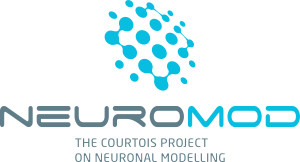A Brief Introduction to Cognitive Neuroscience: {https://drive.google.com/file/d/18pzaJ2LAO5HN4JsgCkx1rnSsju32KLrN/view?usp=sharing}
The aim of this code is to program an fMRI experiment very similar the CIMA-Q memory task with open tools.
Protocol: 15 images are randomly shown to subject in one of four quadrants on screen. 1 target image is shown twice. Subject must press a key when the repeated target image is displayed and indicate in which quadrant it previously appeared.
The experiment actually shows 12 unique images and a target instead of 14 unique and a target to prevent needing to download any more heavy image category folder.
See project abstract here: {https://github.com/mtl-brainhack-school-2019/memory_task_neuromod/blob/master/projectAbstract.md "projectAbstract"}
N.B: You need to have a dedicated graphic card (in most cases) to display the experimental monitor created by the script.
Download, extract (if compressed) and install Psychopy toolbox (select the latest stable version, which is 3.1.5 at the moment).
{https://www.psychopy.org/download.html}
s = pip install psychopyFrom the 'Inanimate' directory on this Drive, download and extract the clothing, food and furniture folders.
{https://drive.google.com/drive/folders/1FbHI3wNBzHRyp8FSZ6wLiyWRXulq-mV9?usp=sharing}
You can use the shutil module to easily navigate through directories (similar to how the Unix Shell commands work)
s = import shutil
s = shutil.move(files,destination) #works just like the Unix Shell mv commandTo make sure all images in a given category (i.e. 'clothing') are formatted appropriately, execute the 'square_resize.py' function on the previously extracted folders in your terminal or IDE.
{https://github.com/mtl-brainhack-school-2019/memory_task_neuromod/blob/master/square_resize.py "Link to function script"}
s = square_resize('categoryNameHere')s = conda install -c anaconda spyder
s = spyder square_resize.py- Create a class (image matrix) containing all images in their respective subcategories and categories to access them all.
- Initiate a stimuli selection function to ensure proper randomization without replacement across each subcategory and categories.
- Create a class containing all images that will be repeated after each trial
- [] Create a noisy image stimulus (distractor) showing up at random moments to avoid habituation phenomenon in subjects brain activity.
- [] IN PROGRESS: missing noisy image - Randomize the presentation of either target, image distractor or noisy distractor across trials.
- [] IN PROGRESS: Adapt the demo code to the main experimental code
- [] Continue compiling creative commons complex images
